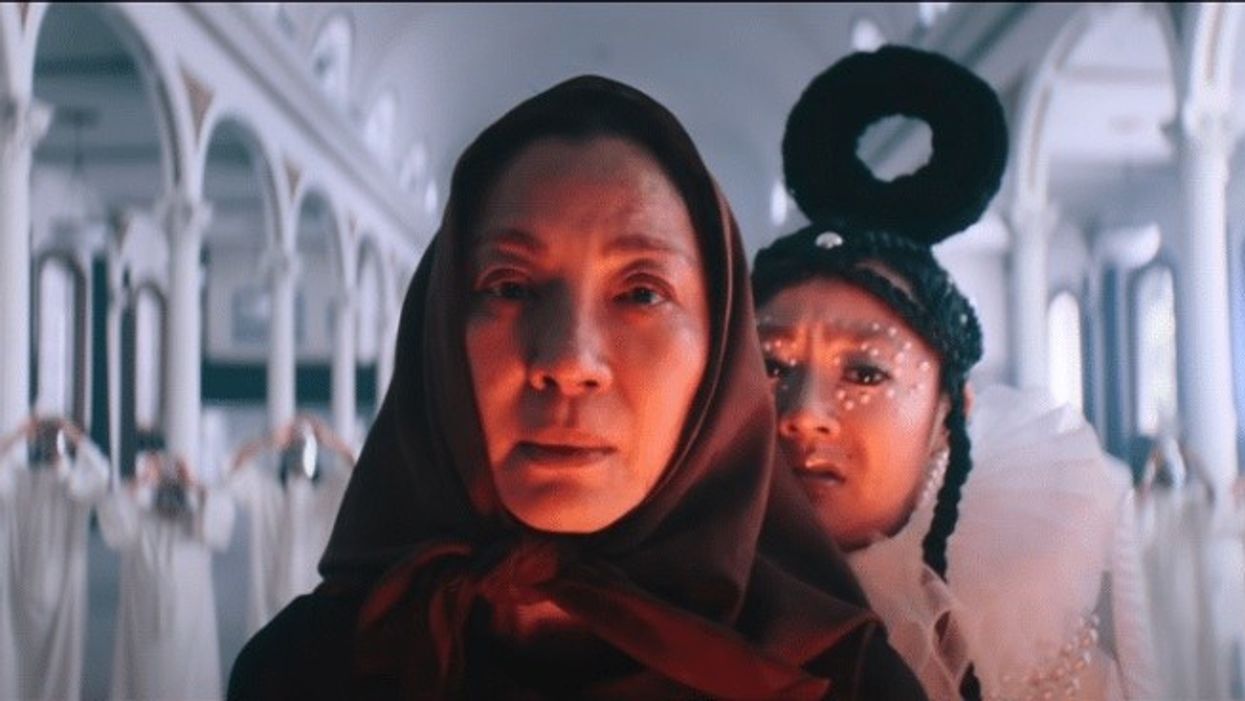How DP Larkin Seiple Made the "Absurdity Even Stronger" in 'Everything Everywhere All at Once'
From custom lighting rigs to capturing rocks in IMAX, DP Larkin Seiple breaks down the cinematography of Everything Everywhere All at Once.

The modern masterpiece Everything Everywhere All at Once is the gift that keeps on giving. From the emotional journey of each character from each universe to the breathtaking homages to the movies of our collective memory, each viewing of the film gives us something new to love and appreciate.
I’ve said it once, and I will say it again. This movie is made to celebrate the chaotically beautiful art of filmmaking. We’ve sat down and picked at the brains of writers and directors Daniel Kwan and Daniel Scheinert (collectively known as Daniels) on the No Film School Podcast, and have read and watched almost every interview that breaks down our favorite scenes from the movie. But one thing we haven’t focused on enough is the brilliant cinematography behind the masterpiece.
Cinematographer Larkin Seiple sat down with Filmmaker Magazine to discuss the “messy but fun way to make something very stupid but very beautiful.” In the interview, Seiple breaks down the making of a rare original, mid-budget box office hit in a post-COVID landscape, and what he took away from making something as absurdity gorgeous, and chaotic as Everything Everywhere All at Once.
Lighting the multiverse
When it came to lighting the multi-genre film, Seiple and Daniels focused on giving each universe it is own feeling. One of the ways the universes were modified to look different amongst the multitude of worlds was the type of lens on Alexa Minis. Once Seiple established what the normal universe would look like, he started testing out lighting and camera lenses for the other universes.
“For the 'Action Verse,' where Ke [Huy Quan] becomes as badass martial arts star, we transitioned to anamorphic to create this classic 1990s action film star vibe, kind of like Die Hard,” Seiple said.
While Die Hard was the inspiration for the “Action Verse,” other universes were defined by other great films. The “Hot Dog Verse,” was shot on Baltars and used all hard light, mimicking the look of The Sound of Music.
“The 'Wong Kar-wai Verse' is much more saturated than, say, In the Mood for Love," he said. "There are moments that are colorful in the film that our brains kind of connected to, even though that movie is more naturally exposed with kind of clean light.”

By referencing the memory of a movie’s aesthetic, Seiple was able to create universes that already had a universal cinematic language that the audience understood instantly.
At one point, Seiple and Daniels wanted to use IMAX to shoot the rock scene at a location about four hours south of LA during the COVID-19 lockdown.
“It would be the silliest use of IMAX in the history of IMAX. But, of course, time and budget forbid it,” Seiple said. Instead of IMAX, Seiple rented Master Prime lenses for the shot but wishes that he had shot in a larger format to make the absurdity even stronger.
Working within restrictions
One of the tricky parts of filming that temporarily stumped Seiple was working within the contrast hints of the IRS building in the normal universe.
Production designer Jason Kisvarday figured out a way to shoot in the large building and not have 500 cubicles’ worth of office supplies in the background. Kisvarday’s set design was made of cardboard and construction paper that add color to the background of an ordinary building, allowing Seiple the freedom to create a lighting setup that could highlight and work with Kisvarday's set design.
“[W]e used Titan tubes, which are LED fluorescents that are wireless. For most of it, we embraced the natural fluorescents, but there’s a whole sequence where Jobu Tupaki (Stephanie Hsu) is first revealed in their universe, and… we swapped out the whole hallway, put in Titans, and spent about two days programming all of these different lighting moves to flicker and change into rainbows to show Jobu flexing her power,” Seiple said about his most challenging lighting set-up.
While the Astera Titan tubes are battery-powered, the pixel mode has to be hardwired to have them react instantaneously to adjustments. Seiple and his gaffer, Matt Ardine, had to go through the entire ceiling and cable the lights for two days.
Another big challenge for Seiple was finding a way to light the massive atrium.
“We didn’t have money to actually light it,” Seiple said in the interview. “We were shooting in winter, so at 5 p.m. we lost all of our light. So, we’d have to basically shoot out the direction facing the atrium, then the remaining four or five hours [of our shoot day] we’d shoot back facing the elevator bank and have to bring in an HMI and bounce it into the ceiling.”

Emotion and light
There is a running theme of moving light of different colors around Evelyn’s (Michelle Yeon) face, connecting the idea that each color is a different version of her. Near the end of the film, Evelyn is simultaneously existing in all the universes, and Matt Ardine built a custom lighting rig with Titan tubes to bring this theme to life.
“[Y]ou can send a color chase through [an individual tube]. We ended up building a triangle light of three tubes next to each other and found a way to rig the camera in that triangle. The fun part was we could actually have the directors come up to the lighting board and swirl the colors with their fingers to mimic what they thought the characters were feeling,” Seiple said.
The passion and love for the craft of filmmaking is what allowed the film to push the beauty of absurdity to its limit.
What were some of your favorite shots from Everything Everywhere All at Once? Let us know in the comments!
Source: Filmmaker Magazine











